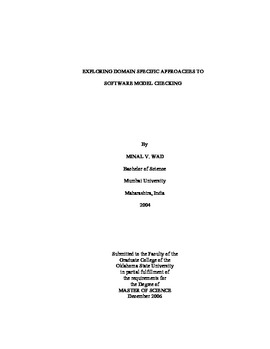| dc.contributor.author | Wad, Minal | |
| dc.date.accessioned | 2014-04-15T18:33:20Z | |
| dc.date.available | 2014-04-15T18:33:20Z | |
| dc.date.issued | 2006-12-01 | |
| dc.identifier.uri | https://hdl.handle.net/11244/8262 | |
| dc.description.abstract | Model checking has proven to be an effective technology for verification and debugging in hardware domains and more recently in software domains. The major challenges in the application of model checking to software systems are: the mapping of software executables to model checker's input language and the intrinsic complexity of the ever growing software systems. This thesis explores the domain specific model checking approaches to large systems in order to optimize the state space storage for specific domains. Bogor [Bogor 2003] is an extensible, customizable, and highly modular model checking framework that supports general as well as domain specific software model checking. As a part of the thesis, domain specific extensions to Bogor's input language, called Bandera Intermediate Representation (BIR), were implemented by providing a plugin for Eclipse [Eclipse 2004]. Eclipse is a universal platform for tool integration and its plugin development environment facilitates addition of new plugins to the existing ones. Eclipse's extension mechanism is exploited by Bogor. Bogor was installed as an Eclipse plugin and with the help of Eclipse's Plugin Development Environment (PDE), new data types were integrated with the existing Bogor framework. Two case studies ('postfix calculator' using stack extension and 'resource allocation' using multiset extension) were investigated. Various metrics such as number of states, transitions, and maximum depth were analyzed. The complexity of the test cases was increased gradually to test the extensions for feasibility and scalability. The thesis also involves a comprehensive study of some of the well-known model checkers and their features, degree of automation, and input languages. It was observed that customizing the model checker as per domain specifications helped in achieving space reduction. The space reduction is prominent, especially in large domains where it contributes towards state space explosion solution. Although development of extensions is achievable, it requires a working knowledge of Eclipse and specific knowledge of model checking. In conclusion, a domain specific approach for software model checking was demonstrated to be a promising technology. Language extensions to BIR were successfully built and tested for accuracy and scalability. | |
| dc.format | application/pdf | |
| dc.language | en_US | |
| dc.publisher | Oklahoma State University | |
| dc.rights | Copyright is held by the author who has granted the Oklahoma State University Library the non-exclusive right to share this material in its institutional repository. Contact Digital Library Services at lib-dls@okstate.edu or 405-744-9161 for the permission policy on the use, reproduction or distribution of this material. | |
| dc.title | Exploring Domain Specific Approaches to Software Model Checking | |
| dc.type | text | |
| osu.filename | Wad_okstate_0664M_2055.pdf | |
| osu.college | Arts and Sciences | |
| osu.accesstype | Open Access | |
| dc.description.department | Computer Science Department | |
| dc.type.genre | Thesis | |
| dc.subject.keywords | model checking | |
| dc.subject.keywords | bogor | |
| dc.subject.keywords | bir | |
| dc.subject.keywords | domain specific | |
